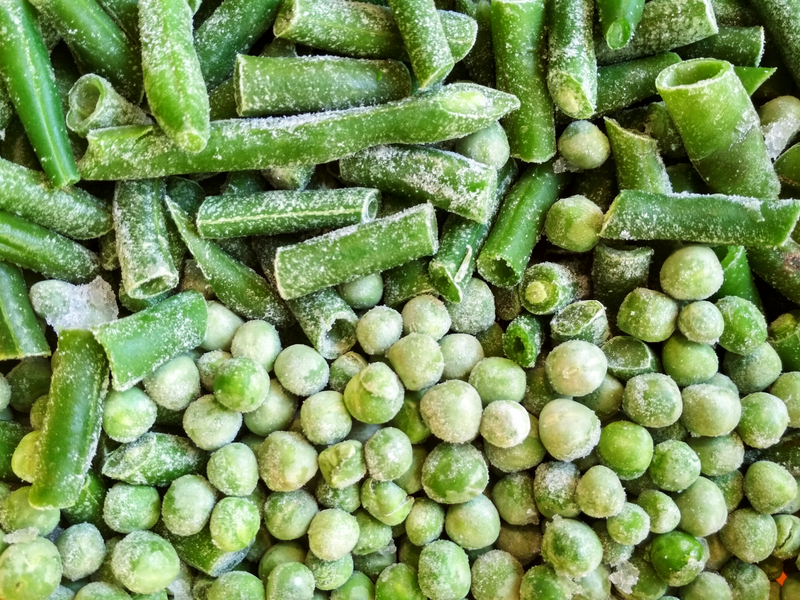Vegetables are a great source of nutrients and fiber. They contain a lot of vitamins and minerals which keep your body in tip-top shape including support for your immune system, hormone production, and every other biochemical reaction needed for optimal health.
Freezing fresh vegetables is a great way to preserve them which reduces food waste, saves money and trips to the grocery store. Whether you didn’t have a change to eat that head of broccoli or there was a special on green beans, freezing them allows you to have a plenty of vegetables on hand for whenever you want them.
You can freeze just about any vegetable except celery, watercress, endive, lettuce, cucumbers and radishes. These foods have a high-water content and become soggy when thawed.
Most vegetables need to be blanched before freezing. Blanching stops the enzyme that causes discoloration, flavor loss and turns them mushy. Blanching also removes dirt and organisms from the vegetables, brightens the color and preserves the vitamins and minerals. The only two exceptions that don’t need blanching and can be frozen in the raw state are onions and peppers. Blanching times varies with each vegetable and its size. Under-blanching stimulates the enzymes and is worse than not blanching at all. Over-blanching causes loss of flavor, color, vitamin and mineral content and can cause the texture to be too soft.
In order to stop the cooking process, you will need to have a bowl of ice water to place the vegetables in after they are done blanching. Water-saving tip: save the blanching and ice-bath water to water plants.
How to Freeze Vegetables
1. Choose vegetables without any blemishes, brown spots or damaged areas. You can cut those away if possible.
2. Wash the vegetables thoroughly in cold water or use a commercial or homemade vegetable wash.
3. Fill a large saucepan or Dutch oven with enough water to cover the vegetables and heat to a boil.
4. Carefully add the vegetables to avoid splashing. Cover and boil according to the chart below.
5. Once finished, remove vegetables from the blanching water and immediately immerse them in a bowl filled with ice water. It takes about the same time to cool as the time it takes for blanching.
6. Remove the vegetables from the ice water with a strainer and pat dry with a towel or paper towel.
7. Place vegetables in a single layer on a baking sheet covered with parchment paper, waxed paper, foil or a silicone baking mat. Make sure not to overcrowd the vegetables.
8. Once frozen, transfer the vegetables to a zipper freezer bag. Label and date the bag and freeze up to 3 months.
When you are ready to use your vegetables, allow them to thaw and cook them as if they were fresh. The cooking time may be shortened by a little due to the blanching.
Vegetable Freezing Instructions:
Asparagus: Sort by size and cut off any stalk ends that are hard. Cut into 2-inch lengths or leave in spears. Blanch small stalks for 2 minutes, medium for 3 minutes and large for 4 minutes. Cool in an ice bath and freeze flat on a baking sheet. Transfer into labeled and dated freezer bag and place in freezer.
Bell Peppers: Remove seeds, cut them into slices or dice. Freeze them in a single layer on covered baking sheet or in a labeled and dated freezer bag. No need for blanching.
Broccoli & Cauliflower: Trim off leaves and remove stems. Cut into 1 ½-inch pieces and blanch for 3 minutes. Cool in an ice bath and freeze flat on a baking sheet. Transfer into labeled and dated freezer bag and place in freezer.
Brussels Sprouts: Trim bottoms and remove any damaged outer leaves. For small ones blanch for 3 minutes, medium for 4 minutes and large for 5 minutes. Cool in an ice bath and and freeze in a single layer on baking sheet. Transfer into labeled and dated freezer bag and place in freezer
Butternut Squash & other winter squash: Chop and cook winter squash fully how you would normally do in the oven or pressure cooker. Cool and freeze in a single layer on baking sheet. Transfer into labeled and dated freezer bag and place in freezer.
Carrots: Remove tops and peel if you wish. Leave small carrots whole. Cut others into ¼-inch cubes, thin slices or lengthwise strips. Blanch for 5 minutes for small, whole carrots and 2 minutes for diced, sliced or strips. Cool in ice bath and freeze in a single layer on baking sheet. Transfer into labeled and dated freezer bag and place in freezer.
Corn: Blanch corn on the cob for 4 minutes. Let cool before removing kernels with a sharp knife. Freeze in a single layer on a baking sheet. Transfer into labeled and dated freezer bag.
Green Beans and Peas: Remove peas from their pods and blanch for 1 ½-minutes. For green beans, blanch for 3 minutes. Cool in ice bath and freeze in a single layer on baking sheet. Transfer into labeled and dated freezer bag and place in freezer.
Greens (beet, collard, chard, kale, spinach): Select tender leaves. Remove any thick stems. Blanch collards for 3 minutes and any other green for 2 minutes. Transfer to a labeled and dated freezer bag and place in freezer.
Onions: Peel skin and any damaged outer layer of the onion. Chop, slice or dice. Freeze them in a single layer on covered baking sheet or in a labeled and dated freezer bag. No need for blanching.
Potatoes: Even when cooked, potatoes have a high-water content. Waxy potatoes, like red potatoes or Yukon gold work best when freezing. Chop the potatoes and par-cook for 5 minutes by either boiling them or baking them in a 475-degree oven. Cool and freeze in a single layer on covered baking sheet. Transfer into labeled and dated freezer bag and place in freezer.
Sweet Potatoes: There are two methods for freezing sweet potatoes. Method 1 (freezing boiled sweet potatoes): Dice the potatoes with or without skin on. Add potatoes to boiling water and cook for about 10 to 15 minutes, or until they just begin to become tender but are still quite firm. Remove sweet potatoes and let them stand at room temperature until cool. Transfer into a labeled and dated freezer bag and place in the freezer. Method 2 (freezing baked sweet potatoes): Heat oven to 375 degrees and place a large baking sheet or heavy-duty foil on the bottom rack of the oven. Scrub the sweet potatoes, poke a few times with a fork and place on the oven rack. Bake for about 1 to 1-1/2 hours, or until tender. Let the potatoes cool in the oven for about an hour. Wrap the cooled potatoes in foil and freeze them whole in a freezer bag for up to 12 months. To reheat the whole sweet potatoes, remove foil. Rewrap them in a new sheet of foil and bake in a 35- degree oven for about 25 to 35 minutes.
Tomatoes: Remove skin before freezing by cutting an “X” on the bottom of the tomato and boil for 30 seconds and cool in an ice bath. The skins should peel off easily. Remove core, leave whole or cut into pieces, transfer into a labeled and dated freezer bag and place in freezer.
Zucchini and Summer Squash: For use in baking, grate the zucchini and blanch for 1 to 2 minutes, until translucent. Pack in freezer bags in quantities normally used in your recipes. For all other uses, cut squash into slices or dices and blanch for 3 to 4 minutes until firm. Cool in an ice bath, transfer into labeled and dated freezer bag and place in freezer.
To learn more, or to set up a virtual telemedicine visit for 1:1 nutritional support, fill out the form below to get started.
Schedule
Please fill out the form to request an appointment at our health and wellness center for the service and location of your preference. We try to get back to all requests as quickly as possible. If you need immediate assistance, please call 773-598-4387.
Your safety comes first: we are operating with heightened safety measures in our clinics and offer telemedicine for those unable to visit in person.









